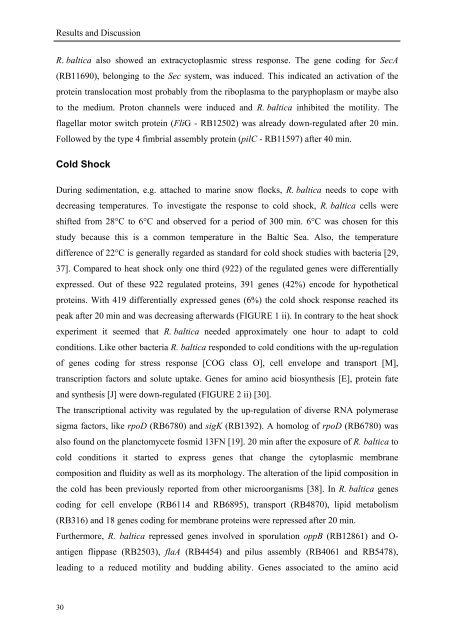a Whole Genome Array Approach - Jacobs University
a Whole Genome Array Approach - Jacobs University
a Whole Genome Array Approach - Jacobs University
Create successful ePaper yourself
Turn your PDF publications into a flip-book with our unique Google optimized e-Paper software.
Results and Discussion<br />
R. baltica also showed an extracyctoplasmic stress response. The gene coding for SecA<br />
(RB11690), belonging to the Sec system, was induced. This indicated an activation of the<br />
protein translocation most probably from the riboplasma to the paryphoplasm or maybe also<br />
to the medium. Proton channels were induced and R. baltica inhibited the motility. The<br />
flagellar motor switch protein (FliG - RB12502) was already down-regulated after 20 min.<br />
Followed by the type 4 fimbrial assembly protein (pilC - RB11597) after 40 min.<br />
Cold Shock<br />
During sedimentation, e.g. attached to marine snow flocks, R. baltica needs to cope with<br />
decreasing temperatures. To investigate the response to cold shock, R. baltica cells were<br />
shifted from 28°C to 6°C and observed for a period of 300 min. 6°C was chosen for this<br />
study because this is a common temperature in the Baltic Sea. Also, the temperature<br />
difference of 22°C is generally regarded as standard for cold shock studies with bacteria [29,<br />
37]. Compared to heat shock only one third (922) of the regulated genes were differentially<br />
expressed. Out of these 922 regulated proteins, 391 genes (42%) encode for hypothetical<br />
proteins. With 419 differentially expressed genes (6%) the cold shock response reached its<br />
peak after 20 min and was decreasing afterwards (FIGURE 1 ii). In contrary to the heat shock<br />
experiment it seemed that R. baltica needed approximately one hour to adapt to cold<br />
conditions. Like other bacteria R. baltica responded to cold conditions with the up-regulation<br />
of genes coding for stress response [COG class O], cell envelope and transport [M],<br />
transcription factors and solute uptake. Genes for amino acid biosynthesis [E], protein fate<br />
and synthesis [J] were down-regulated (FIGURE 2 ii) [30].<br />
The transcriptional activity was regulated by the up-regulation of diverse RNA polymerase<br />
sigma factors, like rpoD (RB6780) and sigK (RB1392). A homolog of rpoD (RB6780) was<br />
also found on the planctomycete fosmid 13FN [19]. 20 min after the exposure of R. baltica to<br />
cold conditions it started to express genes that change the cytoplasmic membrane<br />
composition and fluidity as well as its morphology. The alteration of the lipid composition in<br />
the cold has been previously reported from other microorganisms [38]. In R. baltica genes<br />
coding for cell envelope (RB6114 and RB6895), transport (RB4870), lipid metabolism<br />
(RB316) and 18 genes coding for membrane proteins were repressed after 20 min.<br />
Furthermore, R. baltica repressed genes involved in sporulation oppB (RB12861) and O-<br />
antigen flippase (RB2503), flaA (RB4454) and pilus assembly (RB4061 and RB5478),<br />
leading to a reduced motility and budding ability. Genes associated to the amino acid<br />
30

















